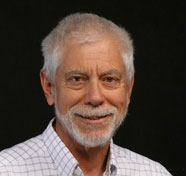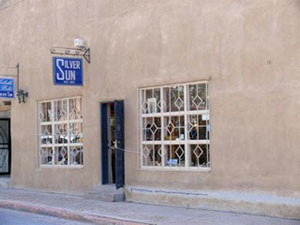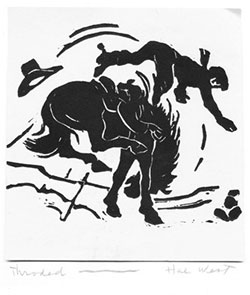

By Robert Wolf
Decorah, IA, USA

Robert Wolf
Background: In the summer of 1966, on summer break from college, I was staying with friends Ross and Tom on Canyon Road in Santa Fe. Across the street from Ross’s rental was the studio of Hal West, one of the last of the colony of older Santa Fe artists.
Hal did not think it proper to drink before five in the afternoon. Around four-thirty most days he would don a tie and jacket, stick a handkerchief in his jacket pocket, pick up his cane and off we would stroll arm-in-arm down Canyon Road, headed for La Fonda.
La Fonda is a big hotel in downtown Santa Fe, on a corner of the Plaza. Inside is a red-tiled lobby with plastered pillars, large Spanish colonial chairs and sofas spaced in groups around the pillars.
In those days La Fonda had a dark quiet bar where we would sit at a table and watch people. There was always a side table with a steaming tray of freshly peeled hot green peppers mixed with melted cheese. I would heap two plates with cheese and peppers and another with taco chips. That was our dinner.
Almost always there were people there who knew Hal and would sit and talk with us. If we did not know anyone we would play a game Hal taught me. He would say, “I’ll bet you that the next person that walks in here is a single man,” or else a woman with a husband, or whatever. And we would throw two nickels on the table and wait. Or else we would pick a table of drinkers and try to guess their occupations. Hal might say, “I’ll bet that ole boy with the red tie over there sells insurance.” We would drop our nickels on the table and I would walk over and say, “Excuse me, sir. My friend and I just placed a little bet on you. He says you sell insurance and I say you own a pharmacy.” Almost always the guy would laugh and say we had both lost. (Occasionally one of us actually did win.) Then he would tell us what he did, and if his table were next to ours it usually started a conversation and Hal would tell them he was an artist and show his portfolio of prints and drawings—if he had brought them.

656 Canyon Road (Formerly Claude's Bar)
The prints came from the Cowboy Calendars that Hal had produced years earlier, which featured a woodcut for each month. I have one framed cut that Hal’s son, Jerry, gave me after his father died. It depicts a cowboy in the air, legs spraddled wide as he is tossed over the front end of a pitching bronc. The prints were inexpensive and someone at the table usually bought one.
After two drinks we would walk slowly across the Plaza. The Plaza is a block square and in those days was nothing more than packed earth with cement walks running from its four corners to the obelisk at the center, which was surrounded by circular cement seating.
Sometimes we would stop to drink at the Plaza Bar, which was a meeting place for a cross-section of Santa Fe, from Mexican-Americans and Indians to artists and white-collar workers. One night years after Hal had died, I sat in the Plaza Bar listening to Mexican-Americans at a table behind me arguing loudly when I heard smashing glass and turned to see a woman holding a broken bottle in her hand, screaming at a man across the table. This was not normal behavior for the Plaza, but with such a strange mix of patrons nothing seemed unlikely.
The nearby Palace Restaurant was altogether a different—a subdued restaurant and bar which offered steak and lobster. The Palace had an old ornate back bar and was decorated with florid red wallpaper and paintings in flouncy gold-tinted frames. The décor was inspired by a famous bordello that had once occupied the site.

"Throded" by Hal West
A black-haired, mustached piano player, Jim Nolan, sang and played old-time, often rowdy songs. Whenever we came in Jim would boom, “Hello Hal WEST!” while continuing to play. During breaks, he would come and sit with us.
The last but best bar Hal introduced me to was Claude’s, a short walk up Canyon Road from his studio. Claude’s was the heartbeat of Santa Fe’s bohemian culture. All types gathered there. The owner was Claude James, a woman with the reputation of having personally tossed out several rowdy male customers. According to one friend, Claude’s arm was as thick as his thigh. The few times I saw her she was pleasant but her reputation was such that I did not want to cross her.
One night we made the rounds from La Fonda to the Plaza to the Palace to Claude’s. There I met Jim Morris, a friend of Hal’s from the 1930s, a painter whom Hal had met in New York. Jim had been a student of Tom Benton in Kansas City and was one of two Santa Fe artists featured in a Time magazine story in the 1940s.
Jim’s studio was within sight of Hal’s, and Hal had pointed him out to me several times as Jim made his way up the road. He was short, Hal’s height, slightly paunchy, with gray hair and mustache. This night he was drunk, swaying ever so slightly as he held onto the bar with both hands and talking with a thick tongue. Hal went up to Jim, who was looking the other way, and punched him in the arm. Jim lurched, turning his head at the same time, his eyes widening, saying, “Hal West you son of a bitch!” He stepped forward awkwardly and punched Hal in the arm. Hal laughed delightedly. Jim laughed and said, “You old son of a bitch, buy me a drink.”
“Why hell no, you tight bastard, I’ve known you for twenty years and you’ve never bought me anything, not so much as a sody pop.”
“What do you mean I never did?”
“Name one time.”
“Well, if I didn’t, it was because you’re not worth it.”
Claude’s raged thick with people. The jukebox blasted rock and roll. When Claude’s closed, the three of us staggered arm-in-arm down the middle of Canyon Road, me in the middle.
“Let’s go to my house for a toddy, son,” Hal said to me, so off the three of us stumbled.
At the back door Hal leaned against the wall, swaying while he dug into his coat pockets for the key as I held him up and Jim soliloquized on something wild and detached. Inside we poured ourselves drinks. Finally I became so bleary eyed I went into the main room, took a cushion from a chair, threw it on the floor, lay down and passed out.
This was my introduction to Santa Fe nightlife.
Link:
Free River Press
American Mosaic with Robert Wolf




